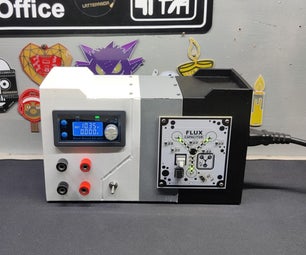Introduction: Make a SUPER Joule Thief Light!
A joule thief is a simple circuit that can take 1.5 volts and put out as much as 5 volts. It can light an LED super bright! But have you ever heard about getting 120 volts out of a AA battery? The Super Joule Thief can do just that! It is perfect for lighting lights during power outages or just for a desk lamp. It can even charge cameras and cell phones! Watch the video for an overview.
Step 1: The Parts
This circuit requires very few parts:
-TIP31 transistor [HAS to be a TIP31 because it works the BEST :) ]
-10k POT
-0.1uf-1uf capacitor (I used a .22uf)
-Ferrite toroid or rod
-20 to 30 feet of 30 gauge magnet wire
-3 feet of 22 gauge magnet wire
-heatsink? (Do you want to power it with more than 1.5 volts?)
-AA battery and holder
-AC output adapter (A 2 prong to 3 prong adapter works great)
-Perfboard
-Epoxy
Scissors, solder, and other tools will also help.
-TIP31 transistor [HAS to be a TIP31 because it works the BEST :) ]
-10k POT
-0.1uf-1uf capacitor (I used a .22uf)
-Ferrite toroid or rod
-20 to 30 feet of 30 gauge magnet wire
-3 feet of 22 gauge magnet wire
-heatsink? (Do you want to power it with more than 1.5 volts?)
-AA battery and holder
-AC output adapter (A 2 prong to 3 prong adapter works great)
-Perfboard
-Epoxy
Scissors, solder, and other tools will also help.
Step 2: The Circuit
UPDATE!! I changed the .22uf capacitor to a .68uf capacitor and I am getting a higher and more stable output. Here is the circuit. As you can see, the transistor acts as an oscillator and pulses the current into the primary coil. This induces a large voltage into the secondary coil. The two prongs of the AC adapter can be connected to the ends of the secondary coil, or you can solder the ends to a light bulb directly. This setup has a 10 kilo-ohm potentiometer. This controls the current that flows to the base of the transistor. More current means a higher voltage in the secondary, and ultimately a brighter light. The .22uf capacitor seemed to improve the output of my toroid, so I left it in. You may have to change the value depending on the resonant frequency of your toroid, or you can just omit it and the circuit will still work great. It is a very simple circuit as you can see.
Step 3: The Toroid Transformer
Let's take a minute to discuss the ferrite toroid. It does not have to be a toroid. If you open up a radio, you will find a ferrite rod inside that has a layer of wire on it. You can take off the wire and use that. Toroids take up less space and they also look nicer. There are several different kinds.
I used a black toroid from a 1983 television. Mine had a white plastic covering on it, so I popped it off. I found out that these toroids with the plastic covering are the best to use. If you would like to make a giant one, use a giant toroid. But the most common are one inch toroids.
They are also different colors. I have used yellow, black, and green, and these have all worked fine. But BEWARE! Some do not work as joule thiefs. It is best to make a normal joule thief and test if that works before doing all the work winding a secondary to find out that it does not resonate.
I used a black toroid from a 1983 television. Mine had a white plastic covering on it, so I popped it off. I found out that these toroids with the plastic covering are the best to use. If you would like to make a giant one, use a giant toroid. But the most common are one inch toroids.
They are also different colors. I have used yellow, black, and green, and these have all worked fine. But BEWARE! Some do not work as joule thiefs. It is best to make a normal joule thief and test if that works before doing all the work winding a secondary to find out that it does not resonate.
Step 4: Winding the Toroid Transformer
First, take some 22 gauge wire and wind 11-15 turns. Use a smaller amount for a smaller toroid, and a larger amount for a larger toroid. Cut the wire at the end of the 11-15 turns, leaving a few inches at the end. Scrape off the enamel coating on the ends of the wire. Next, take another piece of wire and twist it with one of the ends that you previously wound. Wind 4 more turns in the same direction. Cut the wire, leaving a couple inches at the end. Scrape off the enamel from the ends. Now you should have 3 connection points: a start, an end, and a center tap. The center tap is where you twisted the two wires together between the 11-15 turns and the 4 turns. This is your primary coil.
It is a good idea to put a small amount or epoxy over your primary winding to keep it from sliding while you are winding the secondary.
Next, take some 30 gauge wire and start winding the secondary coil. You want to make one layer with the space remaining on the toroid. Then, start winding back over the layer you just wound. Keep doing this until you have around 200-300 turns. More turns = more voltage. I suggest that you wind 50 turns at a time, cut the wire, solder a new piece to it, and wind 50 more turns. This will keep the wire from knotting and breaking and will also let you take breaks without sacrificing coil output voltage. When you are finished, scrape the enamel from the two tips of the secondary and cover the whole toroid in a good layer of epoxy.
It is a good idea to put a small amount or epoxy over your primary winding to keep it from sliding while you are winding the secondary.
Next, take some 30 gauge wire and start winding the secondary coil. You want to make one layer with the space remaining on the toroid. Then, start winding back over the layer you just wound. Keep doing this until you have around 200-300 turns. More turns = more voltage. I suggest that you wind 50 turns at a time, cut the wire, solder a new piece to it, and wind 50 more turns. This will keep the wire from knotting and breaking and will also let you take breaks without sacrificing coil output voltage. When you are finished, scrape the enamel from the two tips of the secondary and cover the whole toroid in a good layer of epoxy.
Step 5: Solder, Solder, Solder!
Now just put the circuit together based on the diagram!
Note what end of the primary connects to the collector, and what end goes to the potentiometer. The longer end will go to the collector.
If you want to get fancy and universal, connect the AC adapter to the secondary's output leads.
The toggle switch should go between the positive input and the center tap.
Note what end of the primary connects to the collector, and what end goes to the potentiometer. The longer end will go to the collector.
If you want to get fancy and universal, connect the AC adapter to the secondary's output leads.
The toggle switch should go between the positive input and the center tap.
Step 6: Putting Everything Together
I epoxied everything onto a piece of perfboard. But feel free to get creative! If you wanted to, you could use a rechargeable AA battery and hook up a solar panel.
REMEMBER! THIS DEVICE OUTPUTS A HIGH VOLTAGE SO IF YOU TOUCH THE SECONDARY LEADS WHILE THE DEVICE IS ON, YOU WILL GET SHOCKED!
It can't kill you, but it is quite uncomfortable.
REMEMBER! THIS DEVICE OUTPUTS A HIGH VOLTAGE SO IF YOU TOUCH THE SECONDARY LEADS WHILE THE DEVICE IS ON, YOU WILL GET SHOCKED!
It can't kill you, but it is quite uncomfortable.
Step 7: Using It!
Now find a light bulb less than 4 watts. LED bulbs work the best. I am using a 0.5 watt LED bulb and it lights up 2x brighter than it does in the wall. Plug it in and flick the switch! If you hear a faint high-pitch humming, it is just the transformer resonating. Use the potentiometer to dim the light if you want. The dimmer the light is, the longer the run time. The run time is about 2.5 hours with a fresh battery on full brightness.
You can use this ti charge cameras and phones too! But it is best used as a light.
If you have any questions, feel free to message me and I would be happy to help out.
Thanks for viewing my instructable and happy making!
You can use this ti charge cameras and phones too! But it is best used as a light.
If you have any questions, feel free to message me and I would be happy to help out.
Thanks for viewing my instructable and happy making!

Runner Up in the
Make It Glow Contest











